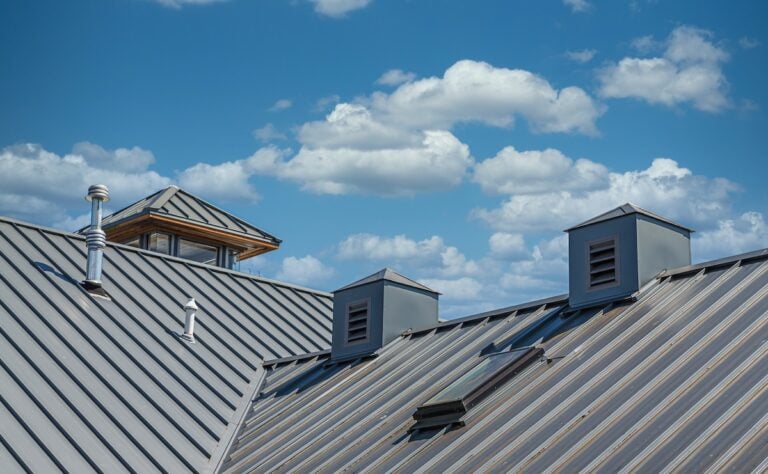
When a storm hits, one of the first things homeowners worry about is the integrity of their roof. High winds, hail, and heavy rain can wreak havoc on your home, leaving you with a damaged roof that needs immediate attention.
Want to tackle it head on? This detailed guide will walk you through everything you need to know about storm damage roof repair, from:
- Identifying damage
- Performing repairs
- Taking preventive measures for the future

Understanding Storm Damage
Storm damage can come in a wide variety of forms and consequences:
Types of Storm Damage
Storm damage can manifest in various forms, each requiring different repair approaches:
- Wind Damage: High winds can lift shingles, tear off roofing materials, or even cause branches and debris to fall onto your roof.
- Hail Damage: Hail can leave dents, cracks, and punctures in roofing materials, compromising their protective capabilities.
- Water Damage: Heavy rain can lead to leaks, mold, and structural issues if your roof is not properly sealed.
Common Signs of Roof Damage
It’s essential to know the signs of roof damage to address issues promptly:
- Missing or lifted shingles
- Dents or cracks in shingles or metal roofing
- Water stains on your ceiling or walls
- Visible mold or mildew
- Debris such as branches on the roof
Initial Steps After a Storm
After a storm, timing is everything. Here are a few things to do to ensure the safety of your home.
Safety First
Before inspecting your roof, ensure that the storm has completely passed and it’s safe to go outside. If you’re uncomfortable with heights or have severe roof damage, it’s best to call a professional.
Conducting a Visual Inspection
Perform a visual inspection from the ground first:
- Walk around your property and look for visible damage.
- Use binoculars to get a closer view of the roof.
- Take notes and photographs of any visible damage for insurance purposes.
Professional Inspection
Consider hiring a professional roofer to conduct a thorough inspection:
- They have the expertise to identify hidden damage.
- They can provide a detailed report for insurance claims.
- Professionals can also offer immediate temporary repairs to prevent further damage.

Repairing Storm Damage
Repairing storm damage to your roof requires a little know how and the right tools!
DIY vs. Professional Repair
Deciding between DIY and professional repair depends on the extent of the damage and your comfort level:
- DIY Repairs can be suitable for minor damage, such as replacing a few shingles or sealing small leaks.
- Professional Repairs are necessary for extensive damage, structural issues, or if you’re unsure about how to proceed safely.
Essential Tools and Materials
- Ladder
- Roofing nails or screws
- Hammer or nail gun
- Roofing cement or sealant
- Replacement shingles or roofing material
- Safety gear (gloves, helmet, safety glasses)
1. Replacing Missing or Damaged Shingles
If you decide to tackle minor repairs yourself, gather the following tools and materials:
- Lift the shingle above the damaged one using a flat pry bar.
- Remove the nails or fasteners holding the damaged shingle in place.
- Slide the new shingle into position and secure it with roofing nails.
- Seal the edges of the new shingle with roofing cement.
2. Sealing Minor Leaks
- Locate the source of the leak by inspecting the attic or ceiling.
- Apply roofing cement or sealant to the affected area.
- Press a patch of roofing fabric into the sealant for added protection.
3. Fixing Gutter Damage
- Clean out debris from the gutters and downspouts.
- Check for loose or damaged sections and reattach or replace them as needed.
- Ensure proper drainage away from the roof and foundation.
Filing an Insurance Claim
You don’t have to shoulder the repair costs all on your own. That’s what insurance is for! Follow these steps to make the insurance claims process a breeze.
Documenting Damage
Thorough documentation is crucial for a successful insurance claim:
- Take clear, detailed photographs of all damage.
- Keep receipts for any temporary repairs or materials purchased.
Contacting Your Insurance Provider
- Notify your insurance company as soon as possible after the storm.
- Provide them with documentation and a detailed description of the damage.
- Schedule an appointment for an adjuster to inspect the damage.
Working with the Adjuster
- Be present during the inspection to point out all areas of damage.
- Ask questions and take notes during the inspection.
- Obtain a copy of the adjuster’s report for your records.
Preventive Measures for Future Storms
Taking action now can save you a headache in the future. Here are some steps to follow in order to prevent a storm damaged roof in the future.
Regular Maintenance
Consistent roof maintenance can help minimize storm damage:
- Inspect your roof twice a year for signs of wear and tear.
- Clean gutters and downspouts to prevent water buildup.
- Trim overhanging branches that could fall during a storm.
Upgrading Roofing Materials
Consider upgrading to more durable roofing materials if your roof is nearing the end of its lifespan:
- Impact-resistant shingles can withstand hail and debris.
- Metal roofing is highly durable and resistant to wind damage.
- Quality underlayment adds an additional layer of protection against leaks.
Installing Roof Anchors and Straps
Roof anchors and straps can provide additional stability to your roof during high winds:
- Roof anchors secure the roof to the wall framing, reducing the risk of wind uplift.
- Straps can reinforce the connection between roof trusses and the walls, adding structural integrity.
Building a Storm Emergency Kit
Having a storm emergency kit on hand can be invaluable during and after a storm:
- Emergency Contact List: Include phone numbers for your insurance company, local roofers, and emergency services.
- Temporary Repair Supplies: Keep roofing tarps, nails, and a hammer for immediate repairs.
- Safety Gear: Have gloves, a hard hat, and safety glasses ready for post-storm inspections.
A Roofing Contractor You Can Count On
Repairing storm damage to your roof can seem daunting, but with the right knowledge and approach, you can restore your roof’s integrity and protect your home. Whether you choose to tackle minor repairs yourself or hire professionals for extensive damage, addressing the issues promptly and thoroughly is crucial.
Remember, consistent maintenance and preventive measures can significantly reduce the risk of future storm damage. Protect your investment by staying vigilant and proactive. And if you need expert help or advice, don’t hesitate to reach out to Palladium Roofing!
Stay safe and keep your home secure!




